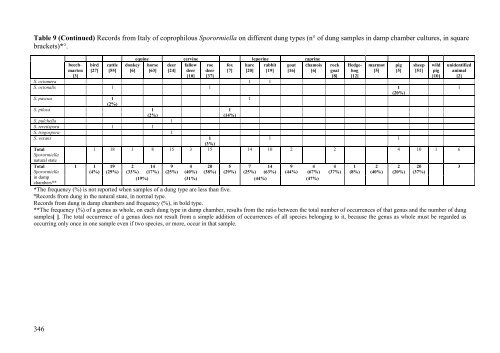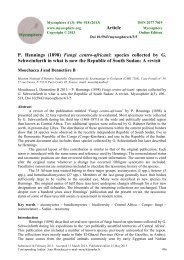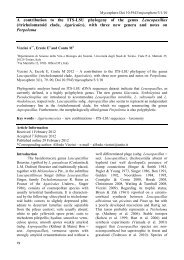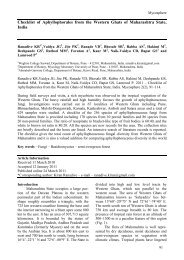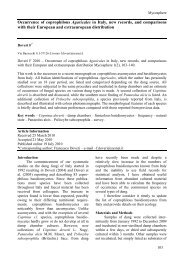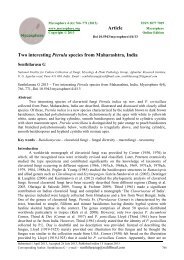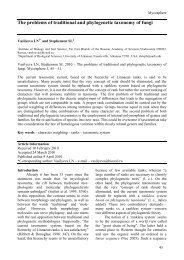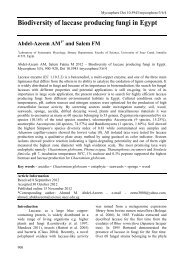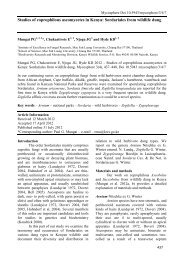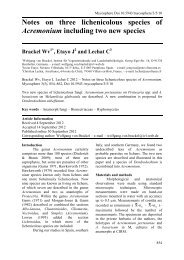Fungi Fimicoli Italici - Mycosphere-online journal
Fungi Fimicoli Italici - Mycosphere-online journal
Fungi Fimicoli Italici - Mycosphere-online journal
You also want an ePaper? Increase the reach of your titles
YUMPU automatically turns print PDFs into web optimized ePapers that Google loves.
Table 9 (Continued) Records from Italy of coprophilous Sporormiella on different dung types (n° of dung samples in damp chamber cultures, in square<br />
brackets)*°.<br />
346<br />
beech–<br />
marten<br />
[3]<br />
bird<br />
[27]<br />
cattle<br />
[55]<br />
donkey<br />
[6]<br />
equine cervine leporine caprine<br />
horse<br />
[63]<br />
deer<br />
[24]<br />
fallow<br />
deer<br />
[10]<br />
roe<br />
deer<br />
[37]<br />
S. octomera 1 1<br />
S. octonalis 1 1 1<br />
fox<br />
[7]<br />
hare<br />
[20]<br />
1<br />
(20%)<br />
S. pascua 1<br />
(2%)<br />
1<br />
S. pilosa 1<br />
1<br />
(2%)<br />
(14%)<br />
S. pulchella 1<br />
S. teretispora 1 1<br />
S. trogospora 1<br />
S. vexans 1<br />
(3%)<br />
1 1<br />
Total<br />
Sporormiella<br />
natural state<br />
1 18 1 8 15 3 15 14 10 2 2 4 10 1 6<br />
Total<br />
1 1 19 2 14 9 4 20 5 7 14 9 4 4 1 2 2 20<br />
3<br />
Sporormiella<br />
(4%) (29%) (33%) (17%) (25%) (40%) (38%) (29%) (25%) (63%) (44%) (67%) (37%) (8%) (40%) (20%) (37%)<br />
in damp<br />
chambers**<br />
(19%) (31%) (44%) (47%)<br />
*The frequency (%) is not reported when samples of a dung type are less than five.<br />
°Records from dung in the natural state, in normal type.<br />
Records from dung in damp chambers and frequency (%), in bold type.<br />
**The frequency (%) of a genus as whole, on each dung type in damp chamber, results from the ratio between the total number of occurrences of that genus and the number of dung<br />
samples[ ]. The total occurrence of a genus does not result from a simple addition of occurrences of all species belonging to it, because the genus as whole must be regarded as<br />
occurring only once in one sample even if two species, or more, occur in that sample.<br />
rabbit<br />
[19]<br />
goat<br />
[16]<br />
chamois<br />
[6]<br />
rock<br />
goat<br />
[8]<br />
Hedgehog<br />
[12]<br />
marmot<br />
[5]<br />
pig<br />
[5]<br />
sheep<br />
[51]<br />
wild<br />
pig<br />
[10]<br />
unidentified<br />
animal<br />
[2]


